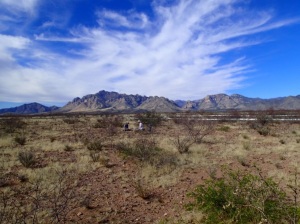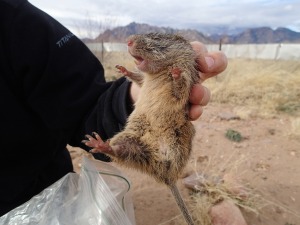Last month brought members of the weecology group (Dr. Morgan Ernest, recent graduates Dr. Glenda Yenni and Dr. Sarah Supp, and current graduate student Erica Christensen) back to Portal for the (approximately) semi-annual plant census. Winter rains had provided us with a decent selection of annual plants to count and identify, which was a welcome contrast to the sparse plant census in spring 2013. The breakout stars this year were smallflowered milkvetch (Astragalus nuttallianus), which showed up hundreds-strong in some quadrats, Esteve’s pincushion (Chaenactis stevioides), and the invasive redstem stork’s bill (Erodium cicutarium). One of the most striking desert flowers found in the area, the California poppy (Eschscholzia californica Mexicana), was also present on many plots.
In total, we identified 28 annual plant species, a marked improvement from the 16 species recorded in the spring census of 2013 and quite similar to the 30 species recorded in 2012. However while species composition was similar in years 2012 and 2014, plant abundances were much lower in 2014. This is likely due in part to differences in total winter precipitation; precipitation was high in 2012, very low in 2013, and somewhere in the middle in 2014.

Abundances of the top 10 species for the past 3 years: Astragalus nuttallianus, Erodium cicutarium, Chaenactis stevioides, Lesquerella gordoni, Descurainia pinnata, Phacelia arizonica, Linanthus bigelovii, Eschscholzia californica mexicana, Eriastrum diffusum, Lepidium lasiocarpum
We also used the trip to perform some much-needed maintenance on the site. The low fences around each of our 24 experimental plots require frequent upkeep to prevent the rodents from tunneling under or climbing over them, but there is also a barbed wire cattle fence around the perimeter of the 20 ha site that has gotten very little care in the past decade or so. It only came to my attention in March, when I was surprised to find a very large herbivore chewing his cud on my study site. We were able to chase him off with minimal damage (either physical or emotional) to man and beast, but the experience inspired me to request the help of my PhD adviser in repairing some conspicuous holes in the perimeter fence. So how many PhDs does it take to mend a barbed wire fence? Turns out one and a half will get it done.
The cow wasn’t the only unexpected herbivore we encountered during the March rodent census. Caught in one of the traps, seen for the first time on the site since 2009, was a tawny-bellied cotton rat (Sigmodon fulviventer). Three species of cotton rat have been recorded at the site (S. fulviventer, S. hispidus, and S. ochrognathus), all of which prefer grass-dominated habitat to shrub-dominated. They have been uncommon but persistent at Portal since its inception in 1977, and were even fairly abundant when the area was dominated by lush grasses in the mid to late 2000s. However recent years have seen decreased rainfall and therefore the plots have been more characteristic of shrubland than grassland, and the Sigmodons moved elsewhere. Does the return of the cotton rat mean a return to grassland is on the horizon?








